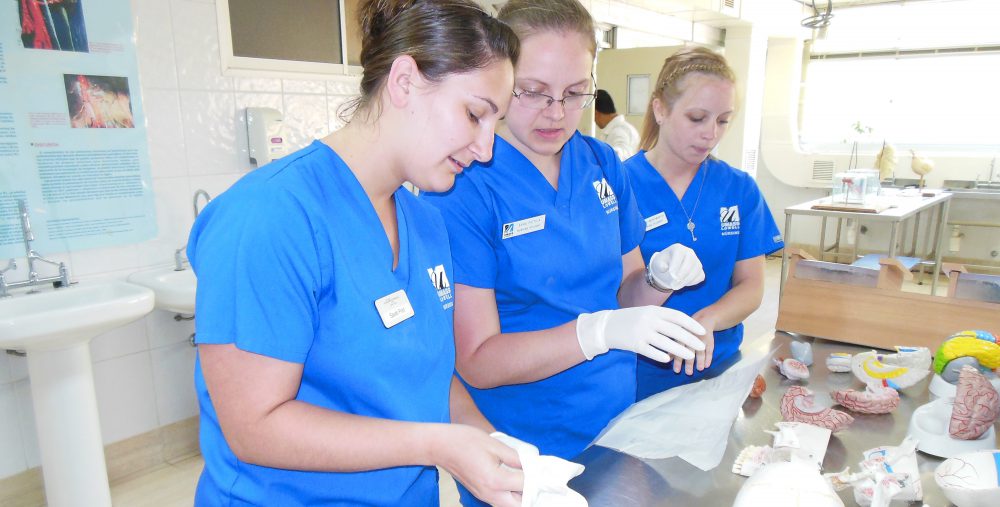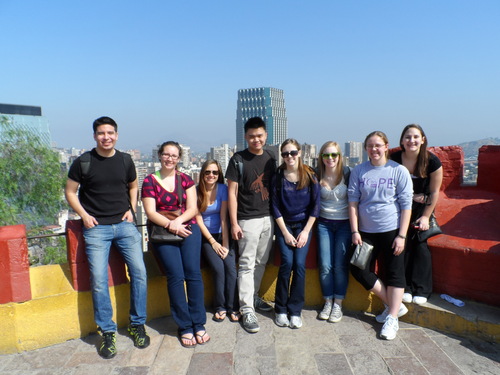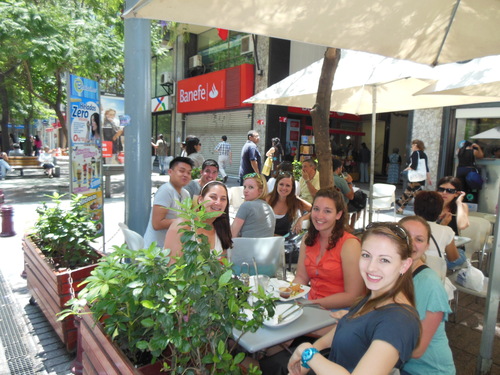Today was our second day of our Talca psychiatric experience. First stop on our list was an out-patient psychiatric clinic. Our expectations were to observe multiple meetings between doctors/nurses and patients, however there was much more depth to this facility. At first we arrived at the wrong clinic (story of our trip). However it gave us the chance to explore and observe another area of Talca. We walked a few blocks to the correct location, and saw sidewalks made of crumbled stone with high curbs. Although it was good that they had sidewalks, they were not safe or desirable for those handicapped. We also noticed some buildings and houses that were more wealthy, as well as many that were poor and/or damaged from the 2010 earthquake. There were cracks in homes and chunks of walls and roofs missing.
Earthquake damage to a church in Talca, Chile.
So far every facility we have been to has been temporarily moved due to their previous location being destroyed in the earthquake. The staff mentioned how it took a while to find somewhere, and until then they were giving care on the street outside of their damaged clinic. Despite the deconstruction, there was signs of hope that the community will rebuild. We observed a few construction workers. We also observed a playground/park. It was very clean and well maintained. We saw a woman watering the garden. We were comparing this playground to some of the not so well maintained playgrounds in the United States.
Initially we thought our destination was a house (which it was previously), and we thought we were once again lost, however we saw the nurse wave at us confirming we had the right location. We met the staff and some of the patients, and took a tour around the facility. We noticed a pool, and at first we were concerned for the patients’ safety. We also noticed a courtyard, kitchen area, dining hall, main gathering hall, exam rooms, intervention rooms, and even met their clinic’s therapeutic dog and kitten. The facility was very clean.
We joined the patients in morning exercise, which nine patients and two staff members attended. The nurse says they usually have 10 – 15 patients there each day for their daytime activities. Some patients come every day and stay all day, some a few days a week, some occasionally, and some come only for their medications or meetings with the psychiatrist.
The exercise was an energetic way to start the day while focusing on range of motion and deep breathing. After exercise the patients had breakfast. A part of the routine of this facility is to involve the patients in daily activities and management of the facility. The patients all have rotating each day. Some assist the staff members with cooking breakfast or lunch, some help clean, and others may help take care of the dog. There is a wide range of duties. The nurses, the social worker, the psychologist and other staff members stress the importance of the patients being involved as well as rotating the duties to ensure and promote independence, confidence and meaning to their days.
Katerina Kafkas with Luna the “pet therapist”.
After the patients’ breakfast, the staff graciously organized a tea time gathering for us students and our professor. They were very generous and welcoming. After getting to know everyone better, such as their professional roles and responsibilities, we moved the the main lounge where one rotating staff member (the facility really enjoys rotating the duties among the patients and staff) debriefs the patients on the day’s work. This is where they decided their daily roles, as well as discussed upcoming events including their field trip to the beach. From here the patients had some art therapy involving newspaperclip outs,drawings, writing, etc. We joined the patients during their activity and were able to get to know them better.
We had a great morning at a great facility. The staff members were incredible and well-educated on the aspects of patient and staff relationships and patient well-being. They deeply cared for their patients and worked hard to provide individualized care to each patient and their families. It was a great experience overall. We gained a lot of respect for the facility and staff.
Sorry for the delay of blogs, wifi is sensitive here in Talca. Stay tuned to hear about our trip to the University here and another day of psychiatric experience!!
Sincerely,
Sara, Mariah, and Sarah (the mariah sandwich roomies)



